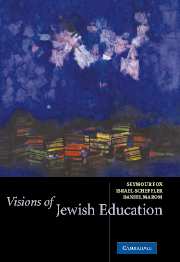Book contents
- Frontmatter
- Contents
- Preface and Acknowledgments
- About the Mandel Foundation
- Introduction
- Part I The Visions Project
- Part II Visions in Detail
- Introduction
- 4 What Must a Jew Study – and Why?
- Supplement: Isadore Twersky
- 5 Jewish Studies in Israel from a Liberal-Secular Perspective
- Supplement: Menachem Brinker
- 6 We Were as Those Who Dream: An Agenda for an Ideal Jewish Education
- Supplement: Moshe Greenberg
- 7 Reflections on the Educated Jew from the Perspective of Reform Judaism
- Supplement: Michael A. Meyer
- 8 Educated Jews: Common Elements
- Supplement: Michael Rosenak
- 9 The Concept of the Educated Person: With Some Applications to Jewish Education
- Supplement: Israel Scheffler
- Part III Visions in Context
- Conclusion: The Courage to Envision
- The Visions Project: Participants and Forums
- Index
8 - Educated Jews: Common Elements
Published online by Cambridge University Press: 08 January 2010
- Frontmatter
- Contents
- Preface and Acknowledgments
- About the Mandel Foundation
- Introduction
- Part I The Visions Project
- Part II Visions in Detail
- Introduction
- 4 What Must a Jew Study – and Why?
- Supplement: Isadore Twersky
- 5 Jewish Studies in Israel from a Liberal-Secular Perspective
- Supplement: Menachem Brinker
- 6 We Were as Those Who Dream: An Agenda for an Ideal Jewish Education
- Supplement: Moshe Greenberg
- 7 Reflections on the Educated Jew from the Perspective of Reform Judaism
- Supplement: Michael A. Meyer
- 8 Educated Jews: Common Elements
- Supplement: Michael Rosenak
- 9 The Concept of the Educated Person: With Some Applications to Jewish Education
- Supplement: Israel Scheffler
- Part III Visions in Context
- Conclusion: The Courage to Envision
- The Visions Project: Participants and Forums
- Index
Summary
As we explore options for educating Jews in our era, two kinds of concerns must inevitably preoccupy us.
On the one hand, we are looking for discrete visions of what is worthy; and we wish to have these visions clearly spelled out. More specifically, we want knowledgeable and scholarly writers to tell us what kinds of Jewish human beings they see as success stories of Jewish education. Who do they think adequately and nobly express the religious, national, and ethical traditions of the Jewish people in this age? Furthermore, we want each of them to suggest, in some curricular detail, what it might mean to nurture such human beings, both as individuals in the world and within meaningful communities and associations.
On the other hand, the very specificity of the visions and their often competing characters require that we ask ourselves whether these visions have commonalities that will permit dialogue and fraternity among Jews of differing orientations and convictions.
Three Educational Dimensions
In answer to the first concern, this volume presents us with distinct models of “the educated Jew” that respond to the question: How do you, the scholar, envision success in Jewish education? The second concern suggests the question: How shall different visions, such as those before us, nourish and not demoralize the wider Jewish community? To spell out the answers to the first question in educational terms and to look toward a solution to the second one, which is my main concern here, we may fruitfully address three fundamental queries to each writer.
- Type
- Chapter
- Information
- Visions of Jewish Education , pp. 178 - 200Publisher: Cambridge University PressPrint publication year: 2003
- 6
- Cited by



